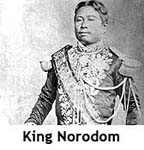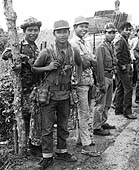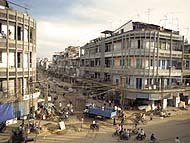As one of the earliest known kingdoms to the region, the Funans rose to power in the 1st century AD, and flourished through the 6th century.
Under the guidance of Fan Shih-man in the early 3rd century, the Funan Kingdom extended its boundary lines as far south as Malaysia and then west towards Burma, establishing a powerful organization of commercial monopolies, setting the way for future empires within the region.
Following the death of ruler Jayavarman I in 681, the kingdom was broken up into several principalities dominated by the Malayans and Javanese.
During the 12th century the Khmer Empire dominated the region, becoming Southeast Asia's largest empire. Conquests brought on by the Khmers were nearly unstoppable, and Angkor (the largest pre-industrial city in the world at the time) was built as the empire's center of power.
The Khmer Empire began to gradually decline through the 13th century, and Angkor was completely abandoned in 1432 following an attack by the Ayutthaya Kingdom. Subsequently, the economy within the region faltered, and Cambodia reached an age of darkness that lasted until the 19th century.
 Cambodia was placed underFrench ruling by King Norodom in 1863, and remained a protectorate until 1953 when, with the help of successor King Norodom Sihanouk, Cambodia finally received their independence.
Cambodia was placed underFrench ruling by King Norodom in 1863, and remained a protectorate until 1953 when, with the help of successor King Norodom Sihanouk, Cambodia finally received their independence. As a new country, Cambodia established itself as a constitutional monarchy, and tried to uphold a policy of neutrality.
However, as the eastern provinces of Cambodia served as bases for the North Vietnamese Army and Viet Cong (NVA/VC) forces operating against South Vietnam in the 1960s, the country found itself on the brink of war as theUnited States began target bombing sections of the NVA/VC.King Sihanouk unsuccessfully attempted to keep the communist North Vietnamesesoldiers from entering the country, as well as the United States and its allies, but only managed to upset the US, who saw Sihanouk as a North Vietnamesesympathizer.
In January of 1970, Sihanouk went abroad due to medical reasons, and in his absence General Lon Nol carried out a coup d'etat against the king.
Under the power of Lon Nol, Cambodia was immediately allied with the US, the monarchy abolished, and the country renamed the Khmer Republic.
 Cambodia became the forefront of worldwide news in 1975 as Communist Khmer Rouge forces captured the capital city of Phnom Penh, and ordered the evacuation of all cities and towns.
Cambodia became the forefront of worldwide news in 1975 as Communist Khmer Rouge forces captured the capital city of Phnom Penh, and ordered the evacuation of all cities and towns. Millions of Cambodians were subsequently executed, and many more died from horrible living conditions.
In 1978, a Vietnamese invasion followed by two decades of fighting drove the Khmer Rouge out, and then in 1993, UN-sponsored elections helped restore some level of normalcy.
A coalition government, formed after national elections in 1998, brought renewed political stability and the surrender of remaining Khmer Rouge forces in 1998.
Still rebuilding from decades of war, Cambodia continues to see an advancement in its economy, and maintains one of the best economic records in Asia in terms of growth.
 The capital city of Phnom Penh, located where the Bassac, Sab and Mekong rivers merge, is the main entry point into the country for travelers, and most tourists journey to this far-off land specifically to visit the ancient temples of Angkor Wat.
The capital city of Phnom Penh, located where the Bassac, Sab and Mekong rivers merge, is the main entry point into the country for travelers, and most tourists journey to this far-off land specifically to visit the ancient temples of Angkor Wat.
No comments:
Post a Comment